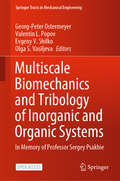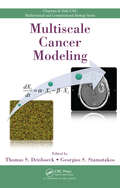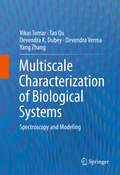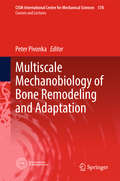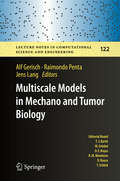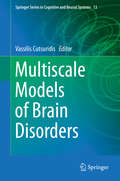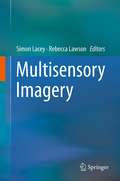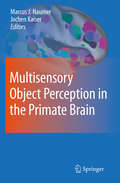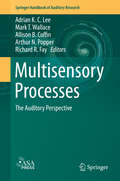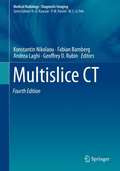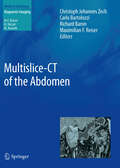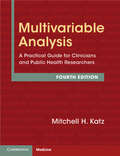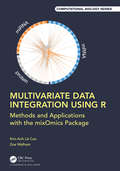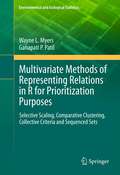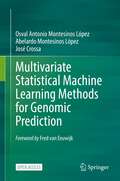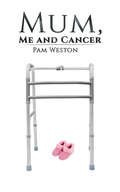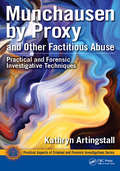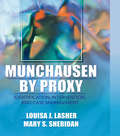- Table View
- List View
Multiresistente Erreger: Diagnostik - Epidemiologie - Therapie
by Rolf Mahlberg Sebastian Schulz-Stübner Markus Dettenkofer Frauke Mattner Alik DawsonIn diesem Buch erläutern Experten praxisnah die wichtigsten Fakten zu Diagnostik und Therapie von Infektionen mit multiresistenten Erregern wie MRSA, VRE, MRGN und MDR-TB. Sie zeigen auf, welche diagnostischen Verfahren sinnvoll sind und welche Antibiotika bei welchen Infektionen greifen. Die Autoren beschreiben, durch welche Hygienemaßnahmen und Präventionskonzepte des Antiotika-Stewardship, sich Infektionen und Resistenzen vermeiden lassen. Auch auf die psychologischen Aspekte im Umgang mit Patienten, Angehörigen, medizinischem Personal und der Öffentlichkeit bei Infektionen durch MRE gehen die Autoren ein. Das Werk wendet sich an alle Ärzte in allen Einrichtungen des Gesundheitswesens, die Patienten mit Infektionen durch multiresistente Erreger betreuen. Die 3. Auflage erscheint komplett aktualisiert und fasst nun auch die therapeutischen Aspekte in einem Werk zusammen.
Multiscale Biomechanics and Tribology of Inorganic and Organic Systems: In memory of Professor Sergey Psakhie (Springer Tracts in Mechanical Engineering)
by Valentin L. Popov Georg-Peter Ostermeyer Evgeny V. Shilko Olga S. VasiljevaThis open access book gathers authoritative contributions concerning multiscale problems in biomechanics, geomechanics, materials science and tribology. It is written in memory of Sergey Grigorievich Psakhie to feature various aspects of his multifaceted research interests, ranging from theoretical physics, computer modeling of materials and material characterization at the atomic scale, to applications in space industry, medicine and geotectonics, and including organizational, psychological and philosophical aspects of scientific research and teaching as well. This book covers new advances relating to orthopedic implants, concerning the physiological, tribological and materials aspects of their behavior; medical and geological applications of permeable fluid-saturated materials; earthquake dynamics together with aspects relating to their managed and gentle release; lubrication, wear and material transfer in natural and artificial joints; material research in manufacturing processes; hard-soft matter interaction, including adhesive and capillary effects; using nanostructures for influencing living cells and for cancer treatment; manufacturing of surfaces with desired properties; self-organization of hierarchical structures during plastic deformation and thermal treatment; mechanics of composites and coatings; and many more. Covering established knowledge as well as new models and methods, this book provides readers with a comprehensive overview of the field, yet also with extensive details on each single topic.
Multiscale Cancer Modeling (Chapman & Hall/CRC Mathematical Biology Series)
by Thomas S. Deisboeck Georgios S. StamatakosCancer is a complex disease process that spans multiple scales in space and time. Driven by cutting-edge mathematical and computational techniques, in silico biology provides powerful tools to investigate the mechanistic relationships of genes, cells, and tissues. It enables the creation of experimentally testable hypotheses, the integration of dat
Multiscale Characterization of Biological Systems
by Yang Zhang Vikas Tomar Tao Qu Devendra K. Dubey Devendra VermaThis book covers the latest research work done in the area of interface mechanics of collagen and chitin-based biomaterials along with various techniques that can be used to understand mechanics of biological systems and materials. Topics covered include Raman spectroscopy of biological systems, scale dependence of the mechanical properties and microstructure of crustaceans thin films as biomimetic materials, as well as the role of molecular-level modeling. The use of nanomechanics to investigate interface thermomechanics of collagen and chitin-based biomaterials is also covered in detail. This book also: * Details spectroscope experiments as well as nanomechanic experiments * Reviews exhaustively phenomenological models and Raman spectroscopy of biological systems * Covers the latest in multiscaling for molecular models to predict lab-scale sample properties and investigates interface thermomechanics
Multiscale Mechanobiology of Bone Remodeling and Adaptation
by Peter PivonkaThe book presents state-of-the-art developments in multiscale modeling and latest experimental data on multiscale mechanobiology of bone remodeling and adaptation including fracture healing applications. The multiscale models include musculoskeletal models describing bone-muscle interactions during daily activities such as walking or running, micromechanical models for estimation of bone mechanical properties, bone remodeling and adaptation models, cellular models describing the complex bone-cell interactions taking into account biochemical and biomechanical regulatory factors. Also subcellular processes are covered including arrangement of actin filaments due to mechanical loading and change of receptor configurations.
Multiscale Models in Mechano and Tumor Biology: Modeling, Homogenization, And Applications (Lecture Notes in Computational Science and Engineering #122)
by Alf Gerisch Raimondo Penta Jens LangThis book presents and discusses the state of the art and future perspectives in mathematical modeling and homogenization techniques with the focus on addressing key physiological issues in the context of multiphase healthy and malignant biological materials. The highly interdisciplinary content brings together contributions from scientists with complementary areas of expertise, such as pure and applied mathematicians, engineers, and biophysicists. The book also features the lecture notes from a half-day introductory course on asymptotic homogenization. These notes are suitable for undergraduate mathematics or physics students, while the other chapters are aimed at graduate students and researchers.
Multiscale Models of Brain Disorders (Springer Series in Cognitive and Neural Systems #13)
by Vassilis CutsuridisThis book focuses on our current understanding of brain dynamics in various brain disorders (e.g. epilepsy, Alzheimer’s and Parkinson’s disease) and how the multi-scale, multi-level tools of computational neuroscience can enhance this understanding. In recent years, there have been significant advances in the study of the dynamics of the disordered brain at both the microscopic and the macroscopic levels. This understanding can be furthered by the application of multi-scale computational models as integrative principles that may link single neuron dynamics and the dynamics of local and distant brain regions observed using human EEG, ERPs, MEG, LFPs and fMRI. Focusing on the computational models that are used to study movement, memory and cognitive disorders as well as epilepsy and consciousness related diseases, the book brings together physiologists and anatomists investigating cortical circuits; cognitive neuroscientists studying brain dynamics and behavior by means of EEG and functional magnetic resonance imaging (fMRI); and computational neuroscientists using neural modeling techniques to explore local and large-scale disordered brain dynamics. Covering topics that have a significant impact on the field of medicine, neuroscience and computer science, the book appeals to a diverse group of investigators.
Multisensory Imagery
by Simon Lacey Rebecca LawsonIs a pear sweeter than a peach? Which of Mona Lisa's hands is crossed over the other? What would the Moonlight Sonata sound like played by a brass band? Although these are questions that appeal to mental imagery in a variety of sensory modalities, mental imagery research has been dominated by visual imagery. With the emergence of a well-established multisensory research community, however, it is time to look at mental imagery in a wider sensory context. Part I of this book provides overviews of unisensory imagery in each sensory modality, including motor imagery, together with discussions of multisensory and cross-modal interactions, synesthesia, imagery in the blind and following brain damage, and methodological considerations. Part II reviews the application of mental imagery research in a range of settings including individual differences, skilled performance such as sports and surgical training, psychopathology and therapy, through to stroke rehabilitation. This combination of comprehensive coverage of the senses with reviews from both theoretical and applied perspectives not only complements the growing multisensory literature but also responds to recent calls for translational research in the multisensory field.
Multisensory Object Perception in the Primate Brain
by Marcus Johannes Naumer Jochen KaiserTraditionally, a large proportion of perceptual research has assumed a specialization of cortical regions for the processing of stimuli in a single sensory modality. Perception in everyday life, however, usually consists of inputs from multiple sensory channels. Recently the question of how the brain integrates multisensory information has become the focus of a growing number of neuroscientific investigations. This work has identified both multisensory integration regions and crossmodal influences in brain areas traditionally thought to be specific to one sensory modality. Furthermore, several factors have been identified that enhance integration such as spatio-temporal stimulus coincidence and semantic congruency. Multisensory Object Perception in the Primate Brain elucidates the mechanisms of multisensory integration of object-related information with a focus on the visual, auditory, and tactile sensory modalities. Evidence is presented in four sections: methodological considerations, audio-visual processing, visuo-tactile processing, and plasticity, and includes studies in both human and nonhuman primates at different levels of analysis. Studies range from intracranial electrophysiological recordings to non-invasive electro- or magnetoencephalography, functional magnetic resonance imaging, behavioral approaches, and computational modeling.
Multisensory Processes: The Auditory Perspective (Springer Handbook of Auditory Research #68)
by Arthur N. Popper Richard R. Fay Allison B. Coffin Mark T. Wallace Adrian K. LeeAuditory behavior, perception, and cognition are all shaped by information from other sensory systems. This volume examines this multi-sensory view of auditory function at levels of analysis ranging from the single neuron to neuroimaging in human clinical populations.Visual Influence on Auditory Perception Adrian K.C. Lee and Mark T. WallaceCue Combination within a Bayesian Framework David Alais and David BurrToward a Model of Auditory-Visual Speech Intelligibility Ken W. Grant and Joshua G. W. BernsteinAn Object-based Interpretation of Audiovisual Processing Adrian K.C. Lee, Ross K. Maddox, and Jennifer K. Bizley Hearing in a “Moving” Visual World: Coordinate Transformations Along the Auditory Pathway Shawn M. Willett, Jennifer M. Groh, Ross K. MaddoxMultisensory Processing in the Auditory Cortex Andrew J. King, Amy Hammond-Kenny, Fernando R. NodalAudiovisual Integration in the Primate Prefrontal Cortex Bethany Plakke and Lizabeth M. RomanskiUsing Multisensory Integration to Understand Human Auditory Cortex Michael S. BeauchampCombining Voice and Face Content in the Primate Temporal Lobe Catherine Perrodin and Christopher I. PetkovNeural Network Dynamics and Audiovisual Integration Julian Keil and Daniel SenkowskiCross-Modal Learning in the Auditory System Patrick Bruns and Brigitte RöderMultisensory Processing Differences in Individuals with Autism Spectrum Disorder Sarah H. Baum Miller, Mark T. Wallace Adrian K.C. Lee is Associate Professor in the Department of Speech & Hearing Sciences and the Institute for Learning and Brain Sciences at the University of Washington, SeattleMark T. Wallace is the Louise B McGavock Endowed Chair and Professor in the Departments of Hearing and Speech Sciences, Psychiatry, Psychology and Director of the Vanderbilt Brain Institute at Vanderbilt University, NashvilleAllison B. Coffin is Associate Professor in the Department of Integrative Physiology and Neuroscience at Washington State University, Vancouver, WAArthur N. Popper is Professor Emeritus and research professor in the Department of Biology at the University of Maryland, College ParkRichard R. Fay is Distinguished Research Professor of Psychology at Loyola University, Chicago
Multislice CT (Medical Radiology)
by Andrea Laghi Fabian Bamberg Konstantin Nikolaou Geoffrey D. RubinThe fourth edition of this well-received book offers a comprehensive update on recent developments and trends in the clinical and scientific applications of multislice computed tomography. Following an initial section on the most significant current technical aspects and issues, detailed information is provided on a comprehensive range of diagnostic applications. Imaging of the head and neck, the cardiovascular system, the abdomen, and the lungs is covered in depth, describing the application of multislice CT in a variety of tumors and other pathologies. Emerging fields such as pediatric imaging and CT-guided interventions are fully addressed, and emergency CT is also covered. Radiation exposure, dual-energy imaging, contrast enhancement, image postprocessing, CT perfusion imaging, and CT angiography all receive close attention. The new edition has been comprehensively revised and complemented by contributions from highly experienced and well-known authors who offer diverse perspectives, highlighting the possibilities offered by the most modern multidetector CT systems. This book will be particularly useful for general users of CT systems who wish to upgrade and enhance not only their machines but also their knowledge.
Multislice-CT of the Abdomen
by Richard Baron Maximilian F. Reiser Carlo Bartolozzi Christoph Johannes ZechThis book provides a lucid summary of modern multislice CT imaging of the abdomen, with a focus on the essential imaging findings. After a concise technical introduction, the most important abdominal diseases are described and illustrated with high-quality images. Sections are devoted to the liver and biliary system, the pancreas and spleen, the kidneys and urogenital system, and the bowel and peritoneal cavity. Throughout, key differential diagnostic features are highlighted. The editorial team is composed of internationally renowned radiologists from Europe and the United States, and all chapters have been written by recognized experts in the topic under consideration. Multislice CT of the Abdomen will serve as an excellent reference for radiologists participating in further professional training and will prove an ideal source of information for all who wish to deepen their personal knowledge of the subject.
Multispecies Biofilms: Technologically Advanced Methods to Study Microbial Communities (Springer Series on Biofilms #12)
by Karishma S. Kaushik Sophie E. DarchIn an age of antibiotic resistant infections, the study of biofilms is increasingly important. Microbes more than often exist in complex multi-species or polymicrobial communities, making infections difficult to detect, diagnose and treat. Given the increased focus on studying biofilms in research and laboratory settings, particularly under conditions that closely mimic the clinical state, it is important to get an overview of the recent methods, model systems and tools being developed and employed in this context.This book offers readers the opportunity to learn more about current methods being used in the investigation of multi-species biofilms, both in vivo and in vitro. For this, the book highlights new technologies built and designed for the study of multiple species within biofilm communities, including those that can be leveraged for the evaluation of antimicrobial treatment approaches. The application of these state-of-the-art techniques to further our understanding of multi-species biofilms will be discussed and the reader will learn how the clinical microenvironment and the development of biofilm communities are considered when developing such tools.With cutting-edge contributions from experts in the respective domains, this book will benefit translational and basic research scientists, as well as clinicians, and is an informative resource for educators and their students.
Multisystemic Therapy for Antisocial Behavior in Children and Adolescents
by Scott Henggeler Sonja SchoenwaldMultisystemic therapy (MST) has grown dramatically since the initial publication of this comprehensive manual. Today, over 400 MST programs operate in more than 30 states and 10 countries, supported by a strong empirical evidence base. This book explains the principles of MST and provides clear guidelines for clinical assessment and intervention with delinquent youth and their families. Practitioners are guided to implement proven strategies for engaging clients and helping them to address the root causes of antisocial behavior, improve family functioning and peer relationships, enhance school performance, and build meaningful social supports. New to This Edition Includes the latest MST data and clinical refinements. Revised to be even more user-friendly, with many new examples added. A chapter on treating youth and caregiver substance abuse. Expanded coverage of safety concerns, enhancing vocational outcomes, and MST adaptations for other clinical problems. A chapter detailing the MST system for sustaining high-quality programs.
Multisystemische Therapie bei dissozialem Verhalten von Kindern und Jugendlichen
by Scott W Henggeler Christian Bachmann Melisa D. Rowland Phillippe B. Cunningham Charles M. Borduin Sonja K. SchoenwaldDie multisystemische Therapie (MST) ist ein empirisch abgesichertes Verfahren, das als Alternative zu stationären Behandlungskonzepten auch ambulant angewendet werden kann. In über 30 Ländern wird MST inzwischen erfolgreich mit Kindern und Jugendlichen in über 400 Programmen praktiziert. In diesem Buch werden die Prinzipien der multisystemischen Therapie erläutert. Außerdem bekommen Leser klare Leitlinien an die Hand: für die Indikation und um individuelle Interventionen bei delinquenten Jugendlichen und Kindern zu planen und durchzuführen.
Multivariable Analysis
by Mitchell H. KatzNow in its third edition, this highly successful text has been fully revised and updated with expanded sections on cutting-edge techniques including Poisson regression, negative binomial regression, multinomial logistic regression and proportional odds regression. As before, it focuses on easy-to-follow explanations of complicated multivariable techniques. It is the perfect introduction for all clinical researchers. It describes how to perform and interpret multivariable analysis, using plain language rather than complex derivations and mathematical formulae. It focuses on the nuts and bolts of performing research, and prepares the reader to set up, perform and interpret multivariable models. Numerous tables, graphs and tips help to demystify the process of performing multivariable analysis. The text is illustrated with many up-to-date examples from the medical literature on how to use multivariable analysis in clinical practice and in research.
Multivariable Analysis: A Practical Guide for Clinicians and Public Health Researchers
by Mitchell H. KatzNow in its fourth edition, this best-selling, highly praised text has been fully revised and updated with expanded sections on propensity analysis, sensitivity analysis, and emulation trials. As before, it focuses on easy-to follow explanations of complicated multivariable techniques including logistic regression, proportional hazards analysis, and Poisson regression. The perfect introduction for medical researchers, epidemiologists, public health practitioners, and health service researchers, this book describes how to preform and interpret multivariable analysis, using plain language rather than mathematical formulae. It takes advantage of the availability of user-friendly software that allow novices to conduct complex analysis without programming experience; ensuring that these analyses are set up and interpreted correctly. Numerous tables, graphs, and tips help to demystify the process of performing multivariable analysis. The text is illustrated with many up-to-date examples from the published literature that enable readers to model their analyses after well conducted research, increasing chances of top-tier publication.
Multivariate Analysis of Ecological Data with ade4
by Jean Thioulouse Stéphane Dray Anne-Béatrice Dufour Aurélie Siberchicot Thibaut Jombart Sandrine PavoineThis book introduces the ade4 package for R which provides multivariate methods for the analysis of ecological data. It is implemented around the mathematical concept of the duality diagram, and provides a unified framework for multivariate analysis. The authors offer a detailed presentation of the theoretical framework of the duality diagram and also of its application to real-world ecological problems. These two goals may seem contradictory, as they concern two separate groups of scientists, namely statisticians and ecologists. However, statistical ecology has become a scientific discipline of its own, and the good use of multivariate data analysis methods by ecologists implies a fair knowledge of the mathematical properties of these methods.The organization of the book is based on ecological questions, but these questions correspond to particular classes of data analysis methods. The first chapters present both usual and multiway data analysis methods. Further chapters are dedicated for example to the analysis of spatial data, of phylogenetic structures, and of biodiversity patterns. One chapter deals with multivariate data analysis graphs.In each chapter, the basic mathematical definitions of the methods and the outputs of the R functions available in ade4 are detailed in two different boxes. The text of the book itself can be read independently from these boxes. Thus the book offers the opportunity to find information about the ecological situation from which a question raises alongside the mathematical properties of methods that can be applied to answer this question, as well as the details of software outputs. Each example and all the graphs in this book come with executable R code.
Multivariate Data Integration Using R: Methods and Applications with the mixOmics Package (Chapman & Hall/CRC Computational Biology Series)
by Kim-Anh LeCao Zoe Marie WelhamLarge biological data, which are often noisy and high-dimensional, have become increasingly prevalent in biology and medicine. There is a real need for good training in statistics, from data exploration through to analysis and interpretation. This book provides an overview of statistical and dimension reduction methods for high-throughput biological data, with a specific focus on data integration. It starts with some biological background, key concepts underlying the multivariate methods, and then covers an array of methods implemented using the mixOmics package in R. Features: Provides a broad and accessible overview of methods for multi-omics data integration Covers a wide range of multivariate methods, each designed to answer specific biological questions Includes comprehensive visualisation techniques to aid in data interpretation Includes many worked examples and case studies using real data Includes reproducible R code for each multivariate method, using the mixOmics package The book is suitable for researchers from a wide range of scientific disciplines wishing to apply these methods to obtain new and deeper insights into biological mechanisms and biomedical problems. The suite of tools introduced in this book will enable students and scientists to work at the interface between, and provide critical collaborative expertise to, biologists, bioinformaticians, statisticians and clinicians.
Multivariate Exponential Families: A Concise Guide to Statistical Inference (SpringerBriefs in Statistics)
by Udo Kamps Stefan BedburThis book provides a concise introduction to exponential families. Parametric families of probability distributions and their properties are extensively studied in the literature on statistical modeling and inference. Exponential families of distributions comprise density functions of a particular form, which enables general assertions and leads to nice features. With a focus on parameter estimation and hypotheses testing, the text introduces the reader to distributional and statistical properties of multivariate and multiparameter exponential families along with a variety of detailed examples. The material is widely self-contained and written in a mathematical setting. It may serve both as a concise, mathematically rigorous course on exponential families in a systematic structure and as an introduction to Mathematical Statistics restricted to the use of exponential families.
Multivariate Methods of Representing Relations in R for Prioritization Purposes
by Ganapati P. Patil Wayne L. MyersThis monograph is multivariate, multi-perspective and multipurpose. We intend to be innovatively integrative through statistical synthesis. Innovation requires capacity to operate in ways that are not ordinary, which means that conventional computations and generic graphics will not meet the needs of an adaptive approach. Flexible formulation and special schematics are essential elements that must be manageable and economical.
Multivariate Statistical Machine Learning Methods for Genomic Prediction
by José Crossa Osval Antonio Montesinos López Abelardo Montesinos LópezThis book is open access under a CC BY 4.0 licenseThis open access book brings together the latest genome base prediction models currently being used by statisticians, breeders and data scientists. It provides an accessible way to understand the theory behind each statistical learning tool, the required pre-processing, the basics of model building, how to train statistical learning methods, the basic R scripts needed to implement each statistical learning tool, and the output of each tool. To do so, for each tool the book provides background theory, some elements of the R statistical software for its implementation, the conceptual underpinnings, and at least two illustrative examples with data from real-world genomic selection experiments. Lastly, worked-out examples help readers check their own comprehension.The book will greatly appeal to readers in plant (and animal) breeding, geneticists and statisticians, as it provides in a very accessible way the necessary theory, the appropriate R code, and illustrative examples for a complete understanding of each statistical learning tool. In addition, it weighs the advantages and disadvantages of each tool.
Mum, Me and Cancer
by Pam WestonHaving your father die and your mother come to live with you is bad enough, especially when she is diagnosed with cancer. How will you manage with her in your house? What about organising all the support she needs? How do you balance her needs against a growing number of grandchildren? Then just when you think you've got it covered, you find a lump in your own breast… This is one woman's true story of what happened to her.
Munchausen by Proxy and Other Factitious Abuse: Practical and Forensic Investigative Techniques (Practical Aspects of Criminal and Forensic Investigations #64)
by Kathryn ArtingstallThis book covers Munchausen and Munchausen by Proxy (MBP) though the terms have recently changed. The 2013 DSM-V—the update to the American Psychiatric Association's (APA) diagnostic and classification tool—has classified both Munchausen and MBP as "Factitious Systematic Abuse." While thought to have occurred primarily with children and their caregivers, recent research shows a more widespread problem: such medical abuse to spouses, the disabled, the elderly—even pets. Many involve repeat and long-term instances of hospital and medical fraud. This book covers the syndrome itself, interviewing and investigative aspects, victimology, as well indicators in the event of homicide and death.
Munchausen by Proxy: Identification, Intervention, and Case Management
by Louisa Lasher Mary S SheridanThis step-by-step guide will help you identify and manage cases of this unique form of child maltreatment! Munchausen by proxy (MBP) is a dangerous kind of maltreatment in which a caretaker deliberately and repeatedly exaggerates, fabricates, and/or induces a health problem or problems in someone under his or her care. Munchausen by Proxy: Identification, Intervention, and Case Management is the first book to walk you step-by-step through a suspected MBP maltreatment case from suspicion onward. This skills-based, practical book contains a thorough, up-to-date overview of MBP and includes suggestions for identifying and reporting to child protection agencies, investigating and gathering evidence, and legal and court procedures. Its easy readability and immediate applicability make this text a valuable tool in identifying and preventing this form of child abuse. Munchausen by Proxy is divided into three parts. The first covers the definition of MBP, the role of the perpetrator and victim, and the ethical issues affecting professionals, patients, and family. Part two addresses case work from initial suspicions through the investigative and confirmation/disconfirmation process. The third section is dedicated to case planning and case management once MBP has been confirmed, including intervention, immediate child protection, and legal activities. Those involved in a suspected or confirmed MBP case will learn about: the limits of the DSM-IV as applied to MBP perpetrator-consistent characteristics the MBP situational suspicion indicators the inappropriateness of risk assessment tools developed for other forms of maltreatment the danger when MBP perpetrators realize they are under suspicion and more! This volume is generously enhanced with case examples, sample forms, figures, and representative management plans. In Munchausen by Proxy, authors Lasher and Sheridan-experts in MBP and child protection-have come together to fill the gap in the libraries of anyone who may become involved with a MBP case. This includes child welfare professionals and staff, law enforcement, school personnel, health care practitioners, judges and lawyers, and social workers.

